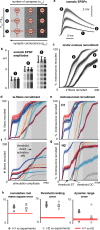Recruitment of upper-limb motoneurons with epidural electrical stimulation of the cervical spinal cord
- PMID: 33469022
- PMCID: PMC7815834
- DOI: 10.1038/s41467-020-20703-1
Recruitment of upper-limb motoneurons with epidural electrical stimulation of the cervical spinal cord
Abstract
Epidural electrical stimulation (EES) of lumbosacral sensorimotor circuits improves leg motor control in animals and humans with spinal cord injury (SCI). Upper-limb motor control involves similar circuits, located in the cervical spinal cord, suggesting that EES could also improve arm and hand movements after quadriplegia. However, the ability of cervical EES to selectively modulate specific upper-limb motor nuclei remains unclear. Here, we combined a computational model of the cervical spinal cord with experiments in macaque monkeys to explore the mechanisms of upper-limb motoneuron recruitment with EES and characterize the selectivity of cervical interfaces. We show that lateral electrodes produce a segmental recruitment of arm motoneurons mediated by the direct activation of sensory afferents, and that muscle responses to EES are modulated during movement. Intraoperative recordings suggested similar properties in humans at rest. These modelling and experimental results can be applied for the development of neurotechnologies designed for the improvement of arm and hand control in humans with quadriplegia.
Conflict of interest statement
G.C., J.B., and S.L. are shareholders and founders of GTX medical, a company producing spinal cord stimulation technologies. G.C., J.B., M.C., B.B., and S.L. are inventors of multiple patent applications and granted patents covering parts of this work. All other authors declare no competing interests.
Figures









Similar articles
-
A computational model for epidural electrical stimulation of spinal sensorimotor circuits.J Neurosci. 2013 Dec 4;33(49):19326-40. doi: 10.1523/JNEUROSCI.1688-13.2013. J Neurosci. 2013. PMID: 24305828 Free PMC article.
-
Electrophysiological Guidance of Epidural Electrode Array Implantation over the Human Lumbosacral Spinal Cord to Enable Motor Function after Chronic Paralysis.J Neurotrauma. 2019 May 1;36(9):1451-1460. doi: 10.1089/neu.2018.5921. Epub 2018 Dec 15. J Neurotrauma. 2019. PMID: 30430902 Free PMC article. Clinical Trial.
-
Selective Recruitment of Arm Motoneurons in Nonhuman Primates Using Epidural Electrical Stimulation of the Cervical Spinal Cord.Annu Int Conf IEEE Eng Med Biol Soc. 2018 Jul;2018:1424-1427. doi: 10.1109/EMBC.2018.8512554. Annu Int Conf IEEE Eng Med Biol Soc. 2018. PMID: 30440659
-
Electrical epidural stimulation of the cervical spinal cord: implications for spinal respiratory neuroplasticity after spinal cord injury.J Neurophysiol. 2021 Aug 1;126(2):607-626. doi: 10.1152/jn.00625.2020. Epub 2021 Jul 7. J Neurophysiol. 2021. PMID: 34232771 Free PMC article. Review.
-
Emergence of Epidural Electrical Stimulation to Facilitate Sensorimotor Network Functionality After Spinal Cord Injury.Neuromodulation. 2019 Apr;22(3):244-252. doi: 10.1111/ner.12938. Epub 2019 Mar 6. Neuromodulation. 2019. PMID: 30840354 Review.
Cited by
-
Targeted deep brain stimulation of the motor thalamus improves speech and swallowing motor functions after cerebral lesions.Res Sq [Preprint]. 2024 Sep 26:rs.3.rs-5085807. doi: 10.21203/rs.3.rs-5085807/v1. Res Sq. 2024. PMID: 39399682 Free PMC article. Preprint.
-
Spatiotemporal Distribution of Electrically Evoked Spinal Compound Action Potentials During Spinal Cord Stimulation.Neuromodulation. 2023 Jul;26(5):961-974. doi: 10.1016/j.neurom.2022.03.007. Epub 2022 May 10. Neuromodulation. 2023. PMID: 35551869 Free PMC article.
-
Optogenetic spinal stimulation promotes new axonal growth and skilled forelimb recovery in rats with sub-chronic cervical spinal cord injury.J Neural Eng. 2023 Sep 12;20(5):056005. doi: 10.1088/1741-2552/acec13. J Neural Eng. 2023. PMID: 37524080 Free PMC article.
-
Cervical transcutaneous spinal stimulation for spinal motor mapping.iScience. 2022 Aug 31;25(10):105037. doi: 10.1016/j.isci.2022.105037. eCollection 2022 Oct 21. iScience. 2022. PMID: 36147963 Free PMC article.
-
Neuromodulation for recovery of trunk and sitting functions following spinal cord injury: a comprehensive review of the literature.Bioelectron Med. 2023 May 29;9(1):11. doi: 10.1186/s42234-023-00113-6. Bioelectron Med. 2023. PMID: 37246214 Free PMC article. Review.
References
Publication types
MeSH terms
LinkOut - more resources
Full Text Sources
Other Literature Sources
Medical

